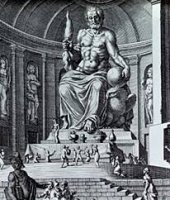
Worksheets and No Prep Teaching Resources
Reading Comprehension Worksheets
Ancient Greece

Ancient Greece
 Worksheets and No Prep Teaching Resources Reading Comprehension Worksheets Ancient Greece |
 Ancient Greece |
| edHelper's suggested reading level: | grades 9 to 12 | |
| Flesch-Kincaid grade level: | 7.87 |
|
The Greeks - Makers of the World Wonders
By Vickie Chao |

|
 1 Have you ever heard of the Seven Wonders of the Ancient World? A Greek writer and poet by the name of Antipater of Sidon was the first person to conceive that idea, sometime during the 2nd century B.C. His choices were probably based on the popular tourist spots of his day. Of the seven monuments that made it on his list that we know today (which may not be the same as Antipater's original list), five of them were closely linked to the same civilization -- Greece. Together, they showcased what a magnificent culture the Greeks had at the time.
1 Have you ever heard of the Seven Wonders of the Ancient World? A Greek writer and poet by the name of Antipater of Sidon was the first person to conceive that idea, sometime during the 2nd century B.C. His choices were probably based on the popular tourist spots of his day. Of the seven monuments that made it on his list that we know today (which may not be the same as Antipater's original list), five of them were closely linked to the same civilization -- Greece. Together, they showcased what a magnificent culture the Greeks had at the time. |
Create Weekly Reading Books
Prepare for an entire week at once! |
| Leave your feedback on The Greeks - Makers of the World Wonders (use this link if you found an error in the story) |
 |
Ancient Greece
|
 |
High School Reading Comprehensions and High School Reading Lessons
|
 |
Social Studies
|